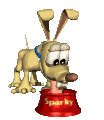|
With roots deeply planted in British soil, the English bulldog is a
stubborn yet relatively docile breed that has been quite popular since the late 1800s.
Initially bred for ferocity and courage, the bulldog is now a devoted and sweet member of
the non-sporting group of dogs.
History & Origin
The English bulldog is the symbol of tenacity and stubborn
determination. Centuries ago, the breed was called the "bandogge" since the dog
spent much of its time bonded to or tied up with other dogs. The earliest reference to
"bulldog" was found in literature in 1609.
The bulldog was originally kept as a butcher’s dog to control
unruly oxen. It was also used as a guard dog, hunting dog and most commonly for the sport
of baiting. This blood sport is now considered cruel and inhumane but in the early 13th
century, it was quite popular. The sport involves tethering the "bait," a bull,
bear, horse, ape or lion, and the dogs were sent in to attack the animal and try to
overpower it. One of the more common baits was the bull. The bulldog was commonly used to
fight the bull, thus resulting in their name. The bulldog would grasp the fleshy nose of
the bull and pin it to the ground. Bull baiting continued for centuries until outlawed in
1835.
The bulldog was accepted into the American Kennel Club in 1976.
Appearance
The bulldog was bred for bull baiting and their facial shape
reflects this. The short muzzle and undershot jaw were necessary to enable a vicelike
grip. The nose is placed far back on the face to allow the dog to breathe while holding a
bull by the fleshy nose. Even though they are no longer bred for bull baiting, their
facial features still reflect their past profession.
The bulldog is a medium-sized dog with a stocky built and broad chest. The legs are short
and bowlegged and the tail is often curled. Their face and head usually is very wrinkled
with many facial folds. The hair coat is short and can be liver, tan, black, white or a
combination.
Size
The bulldog stands 12 to 16 inches at the shoulder and weighs 50 to
60 pounds.
Personality
The bulldog is a stubborn dog but is devoted and quite docile. They
can do well in apartments with the occasional stroll in the park. Bulldogs are not fond of
excessive exercise and do not have boundless energy. They prefer to spend their days
lounging around the house.
Home & Family Relations
The bulldog loves to be in company of family and is generally good
with children. The breed will alert their family to the presence of strangers by barking
and growling but tend not to attack. Their imposing figure is generally enough to ward off
evildoers.
Training
The bulldog doesn’t do very well in obedience training. They
are quite stubborn and tend not to follow instructions quickly. Some feel this trait
indicates that the bulldog is dimwitted but most bulldog owners feel this simply reflects
the bulldogs need to think about things before they act.
Special Care
Due to a surge in popularity, some disreputable breeders have begun
breeding bulldogs without thought to temperament. This has resulted in an increase in
aggression within the breed. Make sure you acquire your bulldog from a reputable breeder
and socialize your puppy at an early age.
Health Concerns
Heat illness occurs
when exposed to excessive environmental temperatures and being unable to dissipate the
heat quickly.
Brachycephalic syndrome is a group of facial
abnormalities that result in difficulty breathing and snorting.
Dystocia is the term used to describe
difficult birthing. Due to their large heads, it is difficult for the mother to pass the
puppies vaginally and most bulldogs have cesareans to deliver their babies.
Facial fold dermatitis is the skin problem that occurs when the
facial folds retain moisture. Infection can occur.
Cryptorchidism is the term used to describe
the situation when one or both testicles do not descend into the scrotum and remain in the
abdomen.
Hip dysplasia is a malformation of the hip
joint that results in pain, limping and arthritis.
Hypoplastic trachea is an undersized windpipe that results in difficulty breathing and can
increase the chances of developing pneumonia.
Hypothyroidism is an underactive thyroid
gland that can result in sluggishness, weight gain and serious illness.
Cherry eye is a prolapse of the third eyelid. Though not a serious injury and does not
cause blindness, the prolapse can be irritating to the surface of the eye and cause
persistent tearing or eye pain.
In addition, bulldogs are prone to mast cell
tumors, elbow dysplasia, lymphoma, acne, deafness,
eyelid problems and heart defects.
The average lifespan for the English bulldog is 8 to 10 years.
|
